Online prediction of EEG based on KRLST algorithm①
Lian Zhaoyang(連召洋),Duan Lijuan②,Chen Juncheng,Qiao Yuanhua,Miao Jun
(*Faculty of Information Technology,Beijing University of Technology,Beijing 100124,P.R.China)
(**Beijing Key Laboratory of Trusted Computing,Beijing 100124,P.R.China)
(***National Engineering Laboratory for Key Technologies of Information Security Level Protection,Beijing 100124,P.R.China)
(****Faculty of Sciences,Beijing University of Technology,Beijing 100124,P.R.China)
(*****Beijing Key Laboratory of Internet Culture and Digital Dissemination Research,School of Computer Science,Beijing Information Science and Technology University,Beijing 100101,P.R.China)
Abstract
Key words:brain computer interface(BCI),kernel adaptive algorithm,online prediction of electroencephalograph(EEG)
0 Introduction
Time series online prediction is widely used in a variety of fields,such as stock trend prediction[1],real-time traffic flow prediction[2],and online monitoring of medical devices[3]and so on.A lot of articles have been published on common datasets, such as Lorenz[4],chaotic time-series prediction[5],respiratory motion[6]and traffic flow prediction[7].However the distribution of the signals on those datasets seems relatively regular and simple in time series.
The electroencephalograph(EEG) signals are randomness and non-stationarity[8],which can better test the robustness and applicability of the kernel adaptive algorithms on processing time-varying signals and non-stationarity signals.In addition,the purpose of modeling and analyzing the time series of EEG signals[9]is to discover and extract valuable information contained in the data,and to reveal the internal relations of EEG signals.The time series prediction of EEG plays an important role in EEG time series analysis.
In Ref.[10],the bag-of-wave features were used to learn EEG synchronization patterns for seizure prediction.In Ref.[11],the machine learning approaches were used for seizure prediction from EEG signals.In Ref.[12],the classical deep learning methods such as convolutional neural network(CNN)were used for seizure prediction from EEG signals.In Ref.[13],the DenseNet was used for epileptic seizure prediction from EEG signals.In Ref.[14],a novel method was proposed for seizure prediction from EEG signals by common spatial pattern(CSP)and CNN.Seizure prediction of EEG signals can predict the impending epileptic seizures according to the scalp EEG signals,so as to improve the quality of life.But the EEG prediction in these articles is based on classification of inter-ictal and pre-ictal state,which is the prediction of disease rather than online prediction of EEG signal itself.Online prediction of EEG signal itself in time series can reconstruct the missing signal,make the signal smoother and eliminate the abnormal points of the EEG signal.
The basic idea of the online prediction in time series is to use the current and historical sequence for mathematical modeling to find the dynamic dependency relation contained in the time series[15].In the practical prediction application,most time series are nonlinear.
On the one hand,the kernel adaptive algorithm[16]inherits the advantages of the adaptive algorithm,which can automatically adjust the parameters of the digital filter according to the input signal[17].On the other hand,it also extends the ability of the adaptive algorithm to solve the nonlinear and non-stationarity signals.
In this paper,the kernel RLS tracker(KRLST)adaptive algorithm is presented to online predict the EEG signal,and compared with the other 13 kernel adaptive algorithms on the brain computer interface(BCI)dataset about motor imagery.It is found that the KRLST algorithm has the best online prediction performance on BCI dataset,that is,the root mean square error(RMSE)of the KRLST algorithm on the all 6 electrodes is the minimum.
1 Online prediction of EEG based on kernel adaptive algorithm
The EEG online prediction in this paper is based on EEG signals at old time points to online predict EEG signals at new time points by using kernel adaptive algorithm.The framework of the algorithm is shown in Fig.1.According to the different ways of minimizing objective function,kernel adaptive algorithms can be roughly divided into two categories,i.e.the improved least mean squares(LMS)and recursive least squares(RLS)algorithms.
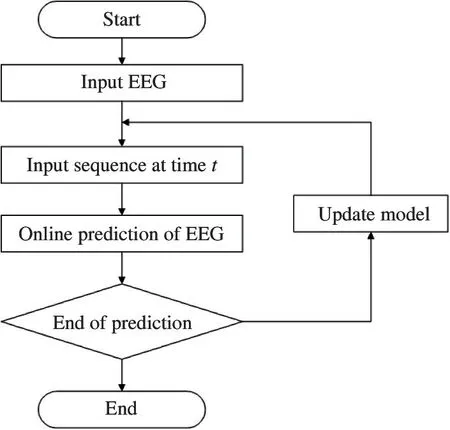
Fig.1 The framework of online prediction of EEG
Naive online regularized risk minimization algorithm(NORMA)is a version of kernel-based LMSalgorithm which includes regularization[18].Leaky kernel affine projection algorithm(LKAPA)adds expansion coefficient in each iteration to avoid cost function posed in the conventional empirical risk minimization(ERM)[19].As the KAPA-3 has a scaling factor,the far past data is scaled down exponentially.
Kernel affine projection(KAP)algorithm proposes a new model simplification standard,which introduces the coherence criterion into sparse dictionary[20].Kernel-based normalized LMS algorithm(KNLMS)uses a new reduction criterion to replace the sparse process[20].The increase of the variables is controlled by several parameters,which is a basic quantitative standard of the dictionary in sparse approximation problem.In the time series prediction problem,KNLMSintroduces correlation criterion to a new kernel reflection projection algorithm.Kernel affine projection sub-gradient method(KAPSM)generalizes the kernelbased normalized LMSalgorithm(KNLMS)and affine projection(AP)algorithm[21].It has strong convergence under mild conditions.Quantized kernel least mean square(QKLMS)uses quantization instead of sparse method to curb the radial growth of adaptive filtering[22].The input space is quantized and compressed by updating the nearest center coefficient and using redundant data.Random Fourier feature kernel LMS(RFF-KLMS)uses inner products in finite dimensions to approximate the kernel function[23].It solves the problem that the computation complexity increases linearly with time.The computational complexity is reduced while maintaining performance.
Multi-kernel normalized LMS algorithm with coherence sparsification(MKNLMS-CS)is an effective adaptive algorithm for nonlinear systems with multi-kernel[24].It adopts adaptive proximal forward-backward splitting method and introduces the L1 form penalty item.Thus the sparsity of the block adaptive algorithm is improved and effective for non-stationary data.Fixed budget quantized KLMS(QKLMS-FB)is a fixed memory budget QKLMS algorithm and uses significance measure to prune[25].The least significant center in the dictionary which is the least influence on the whole system is discarded.Probabilistic LMS(PROBLMS)introduces a probability method to improve LMS algorithm which provides a adaptable step-size LMS algorithm based on the different estimation values[26].In addition,the algorithm also maintains the complexity of standard LMSapproximately.
Sliding window kernel RLS(SWKRLS)only selectsMsamples to model and keeps the latestMsamples at each iteration[27].Extended kernel RLS(E-KRLS)only needs to do inner product operation for input vectors for reproducing kernel Hilbert spaces(RKHS)[28].The method is effective in nonlinear observation and state models.Fixed budget KRLS(FB-KRLS)is fixed memory budget KRLS algorithm[29].The algorithm uses a combination strategy that supports merging and pruning,which can learn nonlinear mapping recursively.Compared with sliding windows,the algorithm is not pruning the oldest data points,but pruning the most unimportance data points.It also add the label,with time tracking ability.
2 Online prediction of EEG based on KRLST algorithm

Specific process of EEG online prediction based on KRLST is as follows.
(1)Set the initial parameters of the model,such asμ1,Σ1,Q1,M,λ,and so on.
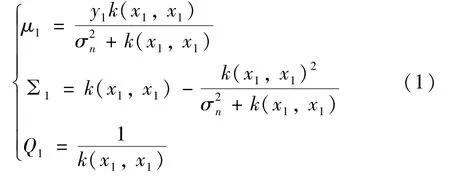
(2)Choose the back to the prior(B2P)forgetting and the B2P forgetting is as follows.

(3)Input signal sequence and output signal.Generating input sequence at timetbased on the input EEG signalxt.



(4)Online prediction.According to the input signalxtat timet,the input signal is mapped to the feature space by kernel function,and the prediction value is calculated through the kernel adaptive algorithm model.


(5)Update prediction model.Ift is online prediction EEG signal estimated by KRLST.Thet+τ+1inparenthesesistheindexofisthevalueofQatiterationt.Subscript means at iterationt. The KRLST algorithm update process is shown in Algorithm 1. Algorithm 1 The KRLST algorithm update process Input:The EEG signals xt;(Output:The online prediction signals EEG 1.Initializeμ1,Σ1,Q1 as Eq.(1)2.Add x1 as Eq.(2)to dictionary Ddict 3.For each t∈[2,3,…]Do 4. Choose B2P as Eq.(2);5. Input sequence xt as Eq.(3)at time t;6. Update qt and uncertaintyγ2t as Eq.(5);7. Update^σ2 ft,^yt,^σ2 yt a(s Eq.(6)and EEG as Eq.(4); 8. Updateμt,Σt as Eq.(7);9. Ifγ2 t<εThen 10. Remove basis t from ut,Σt;11. Else 12. Update Qt as Eq.(7);13. Add basis xt to dictionary Ddict 14. If Number of dictionary>M Then 15. Remove basis i fromμt,Σt,Qt;16. Remove basis xt from dictionary Ddict;17. End if 18. End if 19.End for Return EEG( The RMSE between the predicted signal and the real signal can reflect the deviation degree of the predicted signal and the real signal relatively effectively.It is an important method to evaluate the online prediction performance,and also the comprehensive embodiment of stability and tracking sensitivity.If the algorithm pursues tracking sensitivity unilaterally,the algorithm is easy to over fit,and its stability and generalization performance will be slightly poor.RMSE may be higher before and lower after,and the overall RMSE is slightly higher.If the algorithm pursues stability unilaterally,the tracking sensitivity may be lost and it will take a long time to reach a smaller RMSE value.Although the RMSE value will not vibrate obviously,the overall deviation between the predicted value and the actual signal will be slightly larger,and the overall RMSE is also slightly higher.Only when the stability of the algorithm is relatively good and the tracking sensitivity is fast,the overall RMSE will be relatively low.The RMSE is defined as Adopting the second session of the BCI competition II Ia data set[31],and the subjects of the dataset are healthy.The data is collected in the cerebral cortex of the subjects.The task of motor imagery is to control the motion of the computer screen cursor up and down and record the potential value of the corresponding electrode in the cerebral cortex.The duration of each sample is 6 s.In these 6 s,the first 1 s time is rest,the 1.5 s time in the middle is a reminder of the motor imagery,and the post 3.5 s time is the information feedback.Among them,the post 3.5 s is recorded by 256 Hz with 6 electrodes as samples.There are 561 samples,and each sample contains 6 electrode sample segments and 896 sample points per segment. Fig.2 contains 4 visual sub figures of each electrode which is randomly extracted in 561 samples.The subtitle is composed of electrode number and sample number.Fig.3 is the visualization of some common online prediction datasets,such as Lorenz attractor,Mackey-Glass chaotic time series,respiratory motion and Santa Fe laser time series.It can be seen from the figure that the distribution of 4 commonly used datasets contains some regularity and seems relatively simple on the time series.But the randomness of the data distribution is strong in the time series between inside the single electrode of single sample and the different electrodes of different samples in BCI dataset.It can better test the ability of the kernel adaptive algorithm on processing time varying signals and unstable signals. Because of the difference of brain function,gray matter,white matter and neurotransmitter,the EEG signals at different electrodes will be significantly different,so the prediction results of EEG signals at different electrodes are compared respectively.The competition dataset used in this paper provides a total of six electrode signals,the results of six electrodes are compared.In order to eliminate the influence of individual differences on the results of the algorithm,the RMSE of all 561 samples is chosen in the dataset to do the average again. In this paper,561 samples are randomly disordered to generate dimensions data,and then 14 kernel adaptive algorithms are applied to online predict the EEG signals.The parameters of different algorithms are not exactly the same,but the variation ranges of some key parameters with similar function are set as consistent as possible,such asM,λ,andηin Table 1.Selecting the optimal key parameters of each algorithm in the reference range is similar to the parameter optimization.Other secondary parameters refer to the default optimized parameters in their citations,which is similar to the transfer learning module that directly introduces optimized models and parameters from other fields in deep learning.The key parameters of each algorithm in this paper have been given in Table 1,and have been adjusted adaptively within the range of parameters according to their algorithms.The settings of other secondary parameters can be found in the citations,so as to facilitate other researchers to follow-up experimental reproduction and algorithm improvement.The average RMSE value of 561 samples of each electrode is calculated,and the predictive performance of the adaptive algorithm on each electrode is obtained. Fig.2 The visualization of different electrodes on BCI dataset Fig.3 The visualization of some common online prediction datasets Fig.4 is the line diagram of mean RMSE values by different kernel adaptive algorithms on EEG online prediction of each electrode.Fig.5 is histogram of mean RMSE values by different kernel adaptive algorithms on EEG online prediction of all electrodes.The vertical coordinate in Fig.4 and Fig.5 is voltage value.In Table 2,the horizontal direction represents different kernel adaptive algorithms,and the vertical direction represents different electrodes in the motor imagery dataset.The value of Table 2 is the corresponding average RMSE value.As shown in Table 2,compared with the other 13 algorithms,the KRLST algorithm has the lowest average RMSE value of all the samples on the 6 electrodes of the motor imagery dataset.So the estimated value of KRLST is the closest to the real EEG signal,and its performance is best. Table 1 The parameters setting of different algorithms Fig.4 Line diagram of mean RMSE values by different kernel adaptive algorithms on EEG online prediction of each electrode Fig.5 Histogram of mean RMSE values by different kernel adaptive algorithms on EEG online prediction of all electrodes Table 2 Comparison of mean RMSE values of different kernel adaptive algorithms on EEG online prediction(unit:μV) The data distribution in some common online prediction datasets,such as Lorenz,Chaotic time-series,Respiratory motion,and so on,seems relatively regular and simpler.However,the data distribution of EEG is more random,which can better test the ability to process time-varying signals and unstable signals of the kernel adaptive algorithm.What’s more,the time series prediction of EEG is necessary and important to discover and extract valuable information,and to reveal the internal relations of EEG signals.KRLST algorithm is presented to online predict the EEG,and compared with the other 13 kinds of kernel adaptive algorithms.The experimental results show that KRLST algorithm has the best effect of online prediction on the BCI dataset,and its average RMSE value is the smallest.
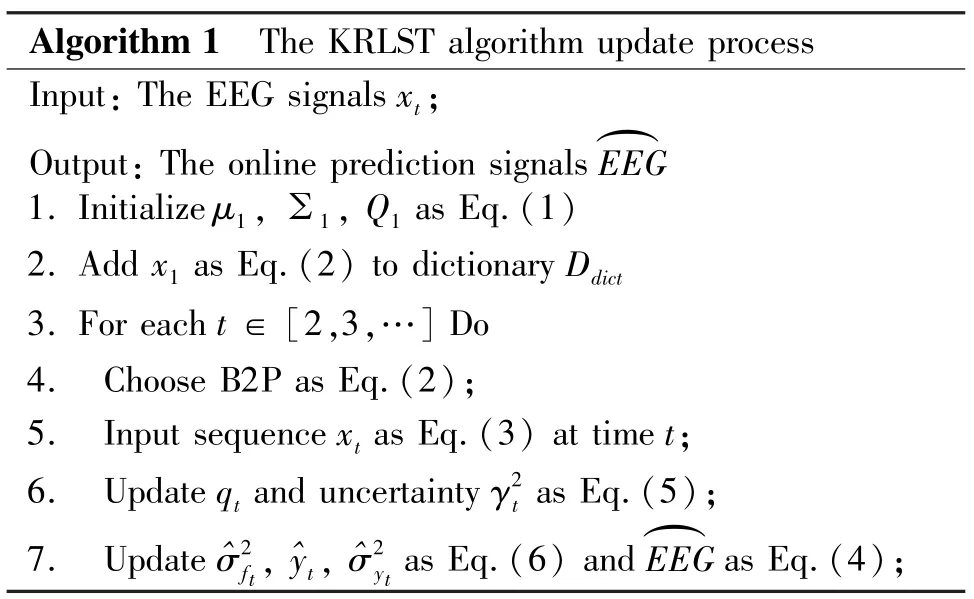
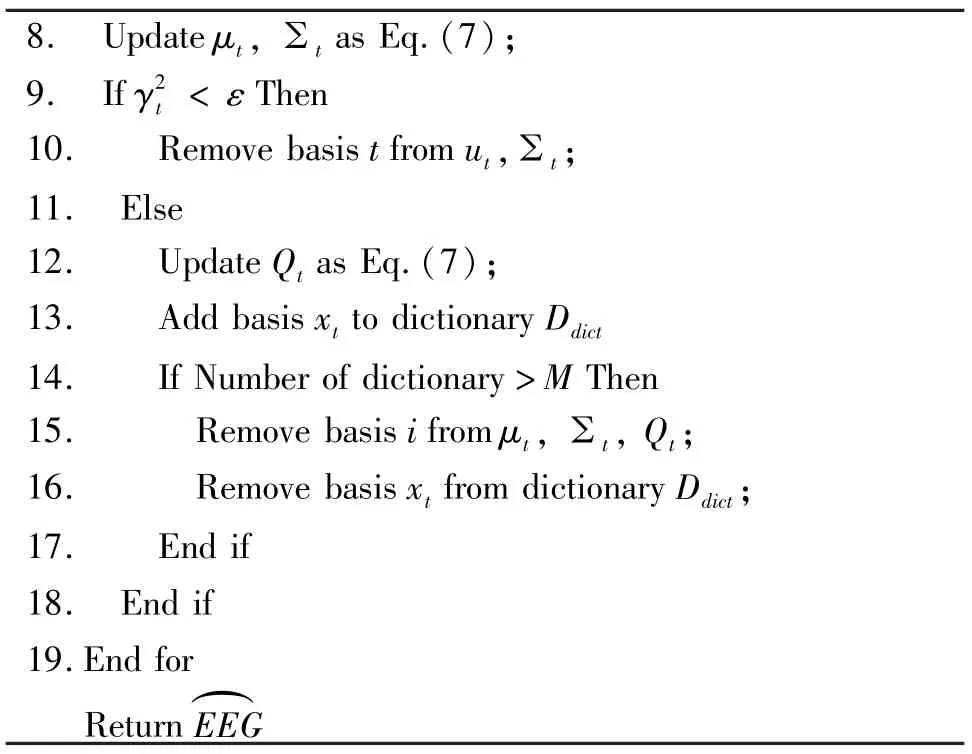
3 Experimental verification
3.1 Evaluation criterion

3.2 Dataset description
3.3 Contrast experiment






4 Conclusion
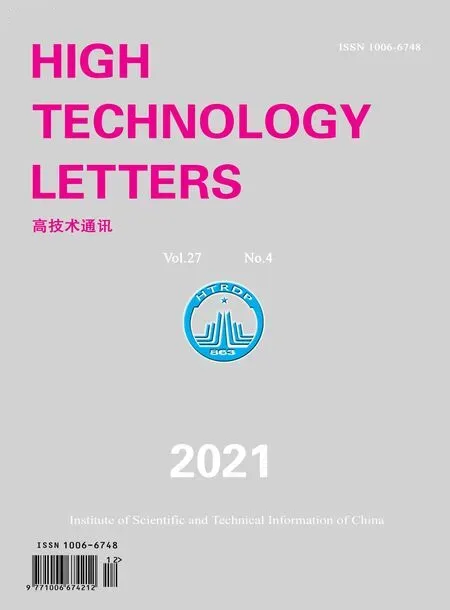 High Technology Letters2021年4期
High Technology Letters2021年4期
- High Technology Letters的其它文章
- A switching-based backstepping sliding mode control for space manipulator in presence of gravity variation①
- A neural network-based commutation optimization strategy and drive system design for brushless DC motor①
- Protective effect of compressing arc extinguishing lightning protection device on superimposed lightning strikes①
- Wedge template optimization and parallelization of depth map in intra-frame prediction algorithms①
- CCD signal acquisition and optimal digital denoise technology①
- Study on spiral winding swimming motion control of a slender legless creature model①
